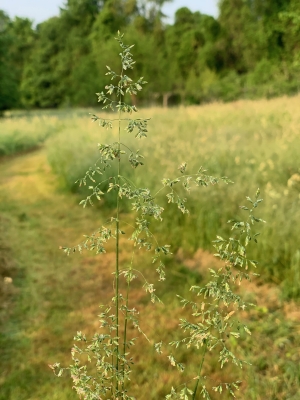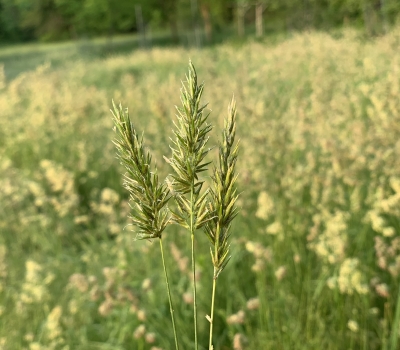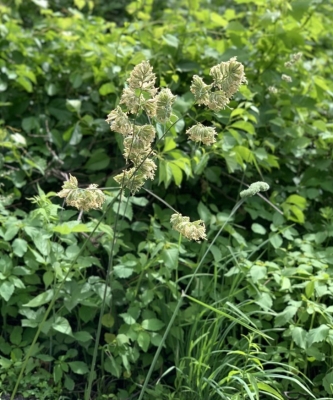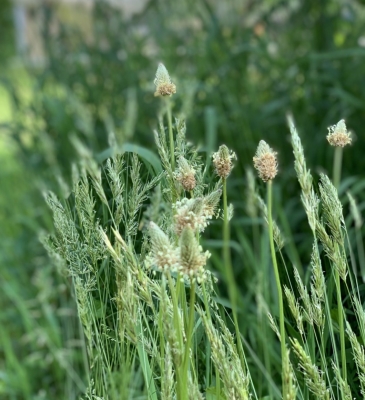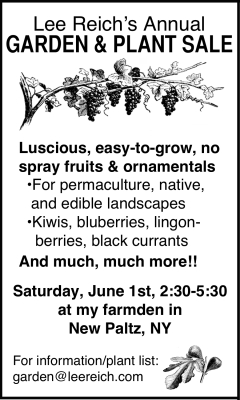Waste Not, Want Not
Two Reasons to Compost
With weeding, harvesting, watering, swimming, kayaking, golf, and biking to do this time of year (not that I do all these), why would anyone spend time making compost? For one or both of two reasons, that’s why.
First, as an environmentally sound way to get rid of so-called “garbage.” Landfilled, the valuable nutrients and organic matter locked up within old broccoli stalks, rotten tomatoes, even old cotton clothes are taken out of our planet’s nutrient cycle almost forever. Landfilling, to me, also disrespects the soil, that thin skin over the Earth that supports much of life here.
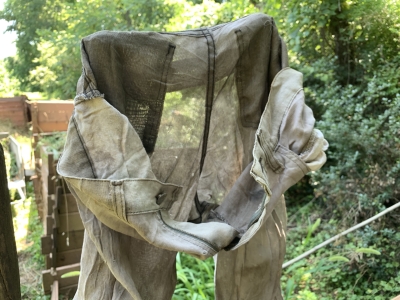
Once Levi’s, now almost compost
This leads to the second reason to make compost now. I require plenty of compost for my gardens so need to scrounge every bit of waste organic material as it becomes available. Even go out of my way to haul it in. Or create it.
Sustainabilityness
Having oodles of compost goes a long way to make a garden or farm truly sustainable. Even though relatively low in nitrogen, as far as plant needs, compost can do away with the need for any other fertilizer.
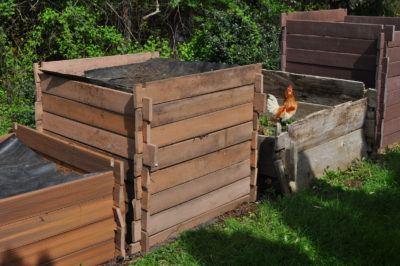
For years, just to make sure that my compost-fed plants were not going hungry — for nitrogen — I spread soybean meal on the ground just before laying down the compost.
Soybean meal provides an organic form of nitrogen but is hardly a sustainable way to nourish the soil. That meal comes from soybeans grown on fields who-knows-where, fed with fertilizers needing fossil fuels for their production, tilled by fossil-fueled tractors, processed in fossil-fueled factories, and transported by fossil-fueled trucks. The same could more or less be said for any fertilizer, organic or otherwise, except compost.
Years ago I made a computation, based on an estimate of how fast nitrogen is released from compost and average nitrogen needs of vegetable plants, of the amount of compost needed to provide all the nourishment a garden would need for one growing season. The amount is about one cubic yard per 300 square feet or, (if you’re a farmer, you should be sitting down), about 70 tons per acre. But these figures are for planted areas, so compost need be applied to only the planting beds.
Also, compost has a residual effect, with only a portion of nutrients being released each year. Yearly additions build soil fertility and nourish a healthy soil life.

On my farmden, a one inch depth of compost provides all the nourishment needed for intensively grown, healthy and healthful crops for an entire season. I just lay the stuff on top of the ground to get the most out of it nutritionally and biologically, and provide a weed-quelling mulch and seedbed.
Self-Analysis
Is making compost truly a way to sustainably nourish the ground? As with so much of agriculture, a balance is sought. Let’s check what goes into my compost piles.
The usual, of course: carrot peelings watermelon rinds, egg shells, old bread, and other fungal and bacterial treats from the kitchen compost bucket; cabbage stalks, old lettuce, and weeds (all even if pest-ridden, diseased, or otherwise) from the garden. I also throw in old cotton or wool clothing, even leather shoes and gloves. Because of noncompostable components such as elastic bands and synthetic cloth parts, they all yield very interesting products staring out in the finished compost.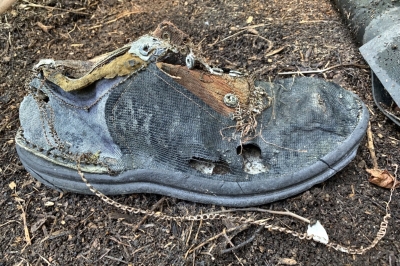 Occasional, light sprinklings of soil add bulk to the finished mix. Occasional, sprinklings of ground limestone keep planted ground, final stop for the compost, in the right pH range.
Occasional, light sprinklings of soil add bulk to the finished mix. Occasional, sprinklings of ground limestone keep planted ground, final stop for the compost, in the right pH range.
Two feedstuffs make up the bulk of the compost. One is horse manure, the most questionably sustainable part of the whole mix. The horse manure is an abundant waste product of a nearby horse farm.

Fashionable
The other feedstuff is hay that I scythe from a one acre field here on the farmden. In mowing hay and composting it, then using the compost to feed my gardens, I am, it seems, “robbing Peter to pay Paul.” But given time, soils regenerate nutrients on their own so I try to rotate which portions of the field I scythe.
Not for You? Then . . .
Making compost isn’t, for reasons of time, space, and inclination, for everyone. In some regions, you can deposit your compostables at a recycling center for composting. And an increasing number of companies are popping up that, for a fee, will pick up your organic waste for recycling. Check web listings for town and county offerings.
I like to make compost, finding it interesting, useful, even enjoyable. And my plants love it.

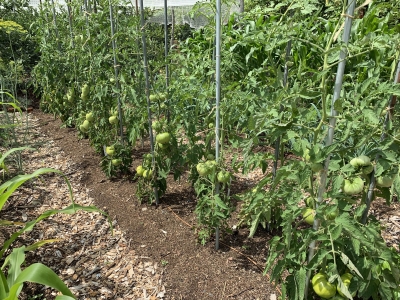 I train my tomato plants to stakes and single stems, which allows me to set plants only 18 inches apart and harvest lots of fruit by utilizing the third dimension: up. At least weekly, I snap (if early morning, when shoots are turgid) or prune (later in the day, when shoots are flaccid) off all suckers and tie the main stems to their metal conduit supports.
I train my tomato plants to stakes and single stems, which allows me to set plants only 18 inches apart and harvest lots of fruit by utilizing the third dimension: up. At least weekly, I snap (if early morning, when shoots are turgid) or prune (later in the day, when shoots are flaccid) off all suckers and tie the main stems to their metal conduit supports.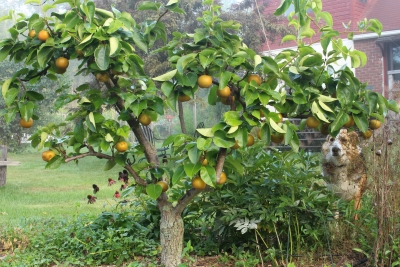 I lop wayward shoots either right back to their origin or, in hope of their forming “spurs” on which will hang future fruits, back to the whorl of leaves near the bases of the shoots.
I lop wayward shoots either right back to their origin or, in hope of their forming “spurs” on which will hang future fruits, back to the whorl of leaves near the bases of the shoots.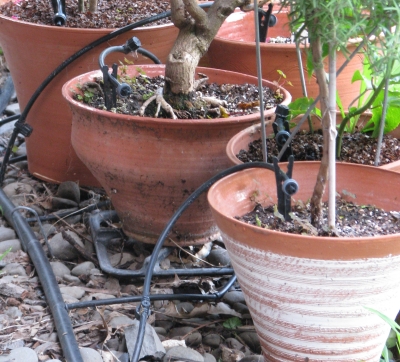 Newly planted trees and shrubs are another story. This first year, while their roots are spreading out in the ground, is critical for them. I make a list of these plants each spring and then water them weekly by hand all summer long unless the skies do the job for me (as measured in a rain gauge because what seems like a heavy rainfall often has dropped surprisingly little water).
Newly planted trees and shrubs are another story. This first year, while their roots are spreading out in the ground, is critical for them. I make a list of these plants each spring and then water them weekly by hand all summer long unless the skies do the job for me (as measured in a rain gauge because what seems like a heavy rainfall often has dropped surprisingly little water).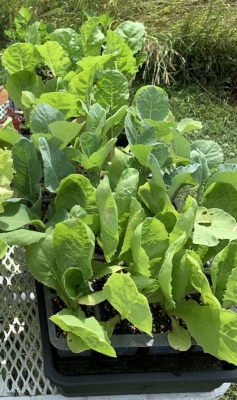 Not only vegetables get this treatment. Buy a packet of seeds of delphinium, pinks, or some other perennial, sow them now, overwinter them in a cool place with good light, or a cold (but not too cold) place with very little light, and the result is enough plants for a sweeping field of blue or pink next year. Sown in the spring, they won’t bloom until their second season even though they’ll need lots of space that whole first season.
Not only vegetables get this treatment. Buy a packet of seeds of delphinium, pinks, or some other perennial, sow them now, overwinter them in a cool place with good light, or a cold (but not too cold) place with very little light, and the result is enough plants for a sweeping field of blue or pink next year. Sown in the spring, they won’t bloom until their second season even though they’ll need lots of space that whole first season.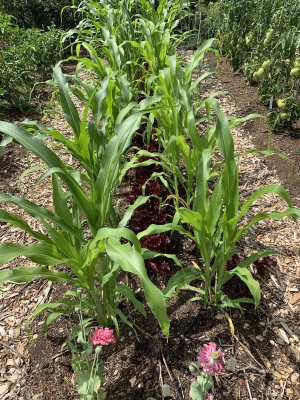 Every time I look at a weed, I’m thinking how it’s either sending roots further afield underground or is flowering (or will flower) to scatter its seed. Much of gardening isn’t about the here and now, so I also weed now for less weeds next season. It’s worth it.
Every time I look at a weed, I’m thinking how it’s either sending roots further afield underground or is flowering (or will flower) to scatter its seed. Much of gardening isn’t about the here and now, so I also weed now for less weeds next season. It’s worth it.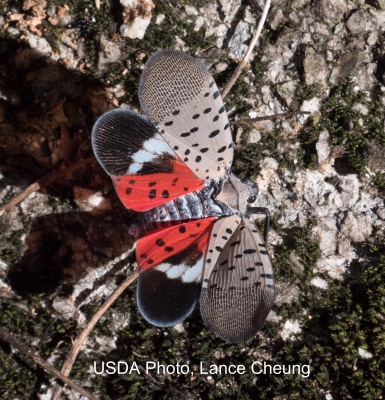
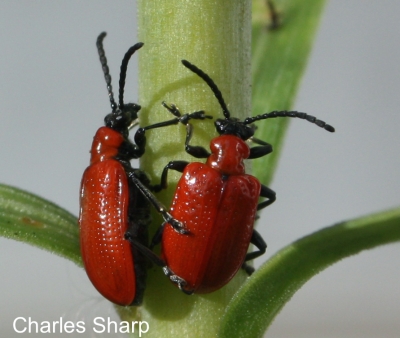 They’ve been making headway across the Northeast since arriving in Cambridge, Massachusetts in 1992. But my lilies still look fine and, yes, I do still see some of those beetles. Perhaps one of the natural predators released in Rhode Island years ago has joined the crowd here, minimizing damage.
They’ve been making headway across the Northeast since arriving in Cambridge, Massachusetts in 1992. But my lilies still look fine and, yes, I do still see some of those beetles. Perhaps one of the natural predators released in Rhode Island years ago has joined the crowd here, minimizing damage.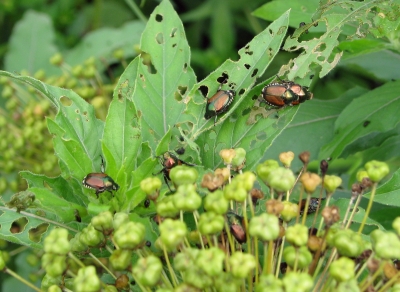 Then, about 10 years later, and since then, they’ve showed up on schedule, which is now, but then disappeared for the rest of the season. Did they go off to greener pastures? Did they succumb to soil nematodes or fungi?
Then, about 10 years later, and since then, they’ve showed up on schedule, which is now, but then disappeared for the rest of the season. Did they go off to greener pastures? Did they succumb to soil nematodes or fungi?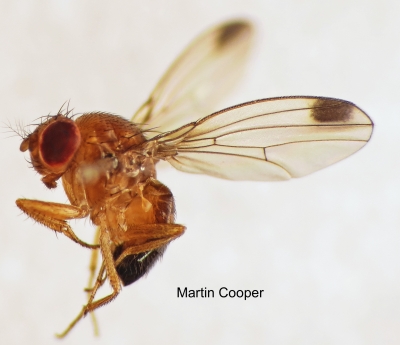 Although chemical, mechanical, and biological controls are still under development, this pest has not put an end to my blueberry-eating days. Thanks to some bait and kill traps developed by Cornell’s Peter Jentsch, damage has been kept to a minimum.
Although chemical, mechanical, and biological controls are still under development, this pest has not put an end to my blueberry-eating days. Thanks to some bait and kill traps developed by Cornell’s Peter Jentsch, damage has been kept to a minimum.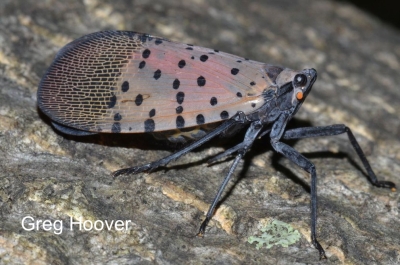 To make matters worse, it also exudes a sticky honeydew which falls on any nearby surface (other leaves, lawn furniture, etc.) and, worse yet, becomes food for a fungus than turns that stickiness dark.
To make matters worse, it also exudes a sticky honeydew which falls on any nearby surface (other leaves, lawn furniture, etc.) and, worse yet, becomes food for a fungus than turns that stickiness dark.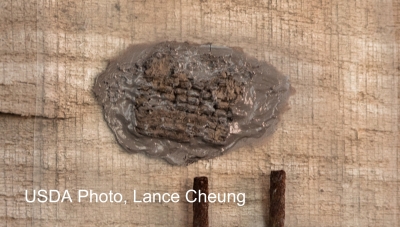 In spring, nymphs hatch and climb trees in search of soft, new growth. The one-inch long adults emerge around now; they’re very mobile, usually jumping but also capable of flying, which is when their spread wings display their bright red color. With wings folded, the insects are mostly gray wings with dark spots.
In spring, nymphs hatch and climb trees in search of soft, new growth. The one-inch long adults emerge around now; they’re very mobile, usually jumping but also capable of flying, which is when their spread wings display their bright red color. With wings folded, the insects are mostly gray wings with dark spots.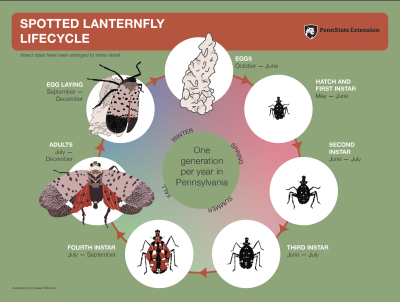 A few natural predators, such as spiders and praying mantises, feast on SLF, but not enough. What to do? There are a few approaches.
A few natural predators, such as spiders and praying mantises, feast on SLF, but not enough. What to do? There are a few approaches.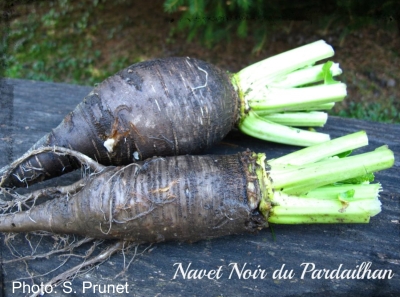 This ancient variety, elongated and with a black skin, has been grown almost exclusively near the Pardailhan region of France. Why am I growing it? The flavor is allegedly sweeter than most turnips, reminiscent of hazelnut or chestnut.
This ancient variety, elongated and with a black skin, has been grown almost exclusively near the Pardailhan region of France. Why am I growing it? The flavor is allegedly sweeter than most turnips, reminiscent of hazelnut or chestnut.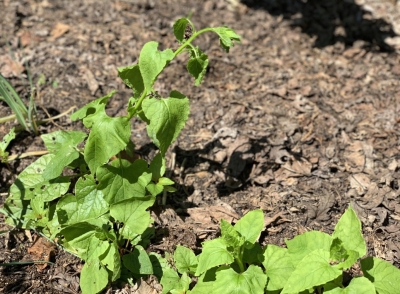 Next year I can expect a vine growing 6 to 9 feet high and which is both decorative and tolerates some shade. What’s not to like? (I’ll report back with the flavor.)
Next year I can expect a vine growing 6 to 9 feet high and which is both decorative and tolerates some shade. What’s not to like? (I’ll report back with the flavor.)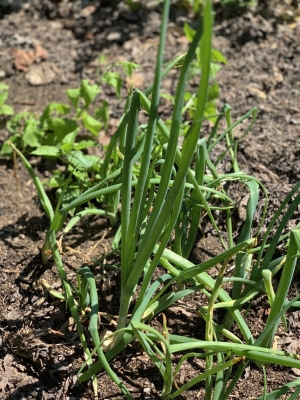 Later in the season, cluster of bulbs form, similar to shallots, although forming larger bulbs. They can overwinter and make new onion greens and bulbs the following years.
Later in the season, cluster of bulbs form, similar to shallots, although forming larger bulbs. They can overwinter and make new onion greens and bulbs the following years.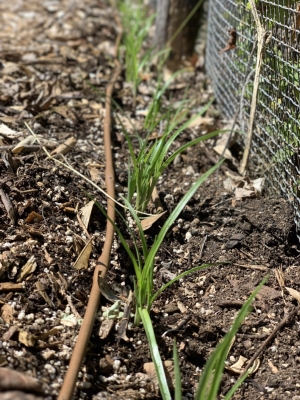
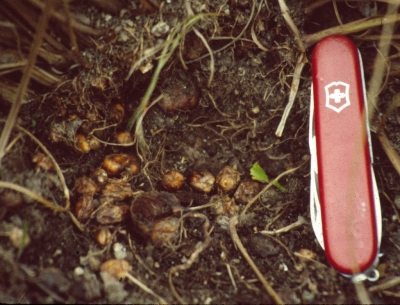 The problem was separating the small tubers from soil and small stones. I have a plan this time around — more about this at harvest time.
The problem was separating the small tubers from soil and small stones. I have a plan this time around — more about this at harvest time.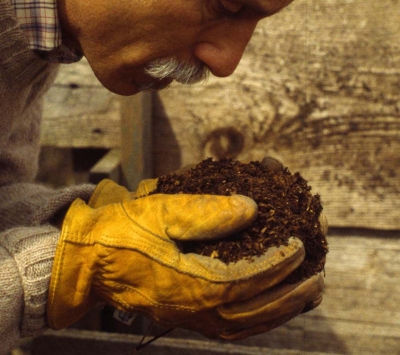
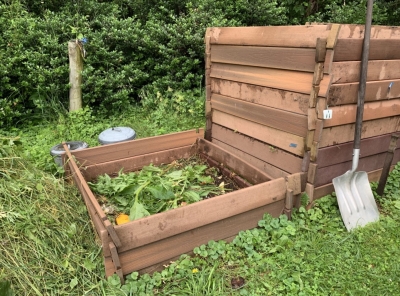
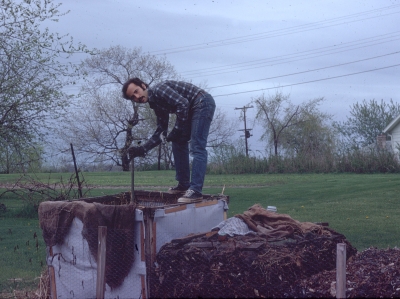 The next bins weren’t bins but just carefully stacked layers of ingredients, mostly horse manure, hay, and garden and kitchen gleanings. And then there was my three-sided bin made of slabwood.
The next bins weren’t bins but just carefully stacked layers of ingredients, mostly horse manure, hay, and garden and kitchen gleanings. And then there was my three-sided bin made of slabwood.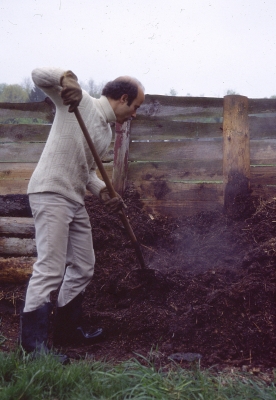
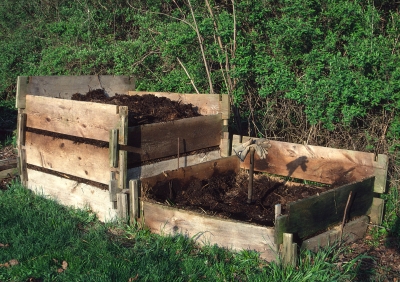 Which brings me to my current bin which, now, after many years of use, I consider nearly perfect. Instead of hemlock boards, these bins are made from “composite lumber.” Manufactured mostly from recycled materials, such as scrap wood, sawdust, and old plastic bags, composite lumber is used for decking so should last a long, long time.
Which brings me to my current bin which, now, after many years of use, I consider nearly perfect. Instead of hemlock boards, these bins are made from “composite lumber.” Manufactured mostly from recycled materials, such as scrap wood, sawdust, and old plastic bags, composite lumber is used for decking so should last a long, long time.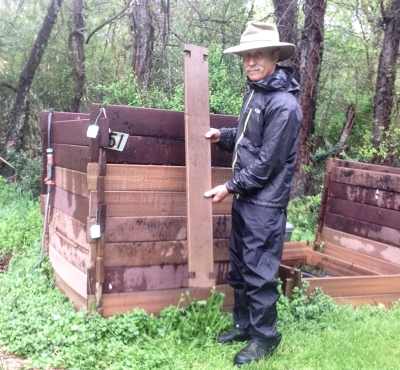 When finished, I ripped one board of the bin full length down its center to provide two bottom boards so that the bottom edges of all 4 sides of the bin would sit right against on the ground.
When finished, I ripped one board of the bin full length down its center to provide two bottom boards so that the bottom edges of all 4 sides of the bin would sit right against on the ground. Before setting up a bin, I lay 1/2” hardware cloth on the ground to help keep at bay rodents that might try to crawl in from below.
Before setting up a bin, I lay 1/2” hardware cloth on the ground to help keep at bay rodents that might try to crawl in from below.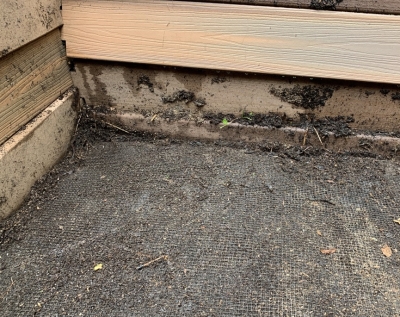 With the Lincoln-log style design, the bin need be only as high as the material within while the pile is being built, and then “unbuilt” gradually as I removed the finished compost.
With the Lincoln-log style design, the bin need be only as high as the material within while the pile is being built, and then “unbuilt” gradually as I removed the finished compost.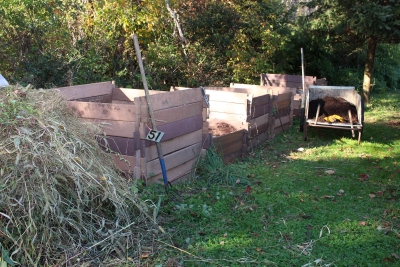
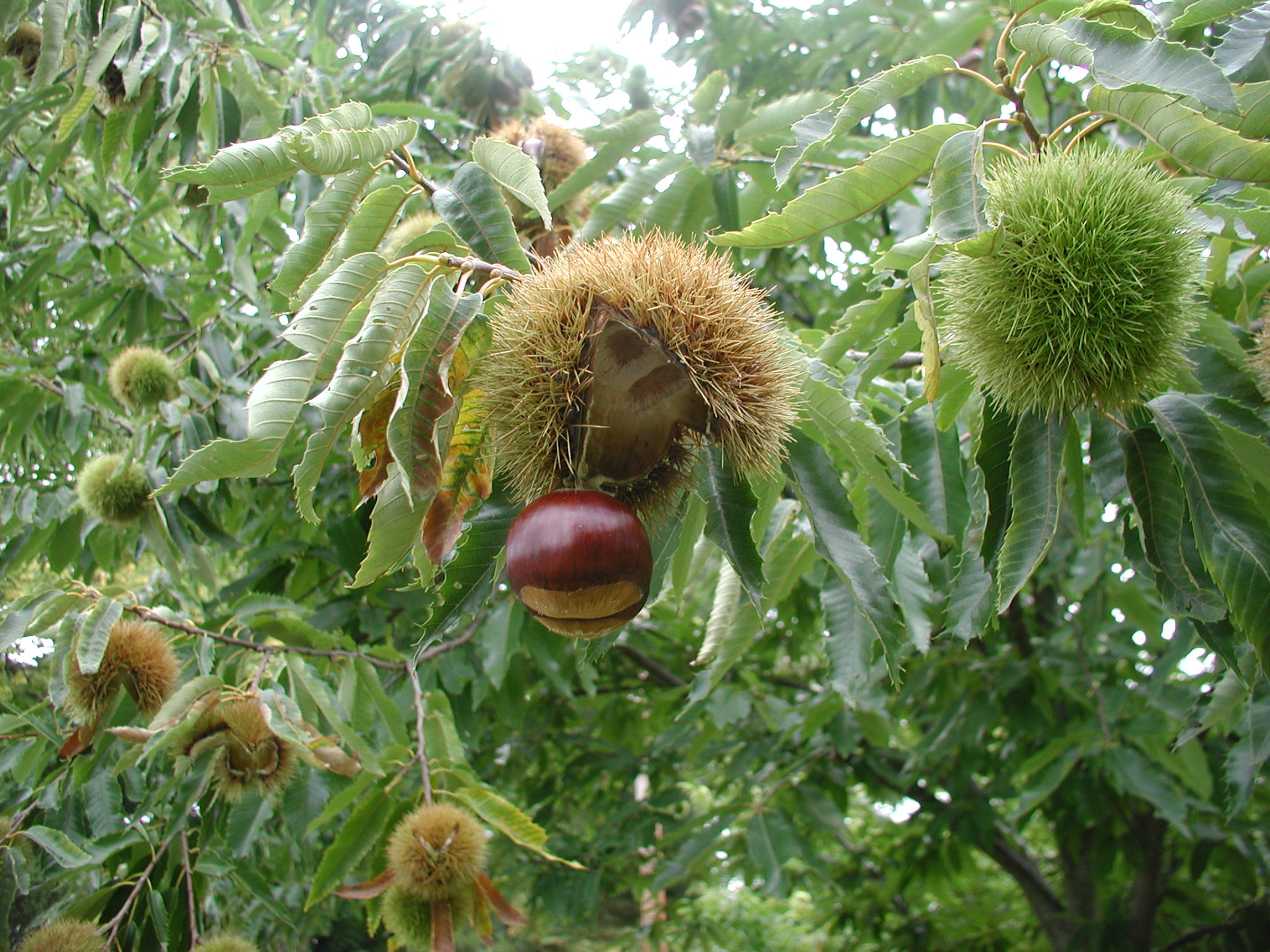 My first inclination, before even identifying chestnut blight as the culprit, was to lop off the two limbs. Once I got up close and personal with the tree, the tell-tale orange areas within cracks in the bark stared me in the face.
My first inclination, before even identifying chestnut blight as the culprit, was to lop off the two limbs. Once I got up close and personal with the tree, the tell-tale orange areas within cracks in the bark stared me in the face.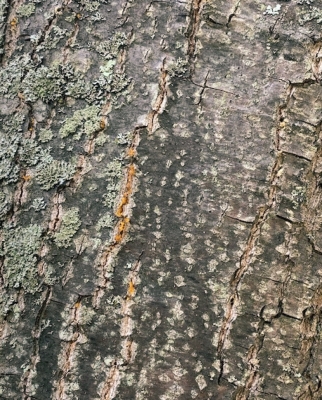 There is no cure for chestnut blight. Removing infected wood does remove a source of inoculum to limit its spread. In Europe, the disease has been limited by hypovirulence, a virus (CHV1) that attacks the blight fungus. Some success has been achieved using a naturally occurring virus found on blighted trees in Michigan.
There is no cure for chestnut blight. Removing infected wood does remove a source of inoculum to limit its spread. In Europe, the disease has been limited by hypovirulence, a virus (CHV1) that attacks the blight fungus. Some success has been achieved using a naturally occurring virus found on blighted trees in Michigan.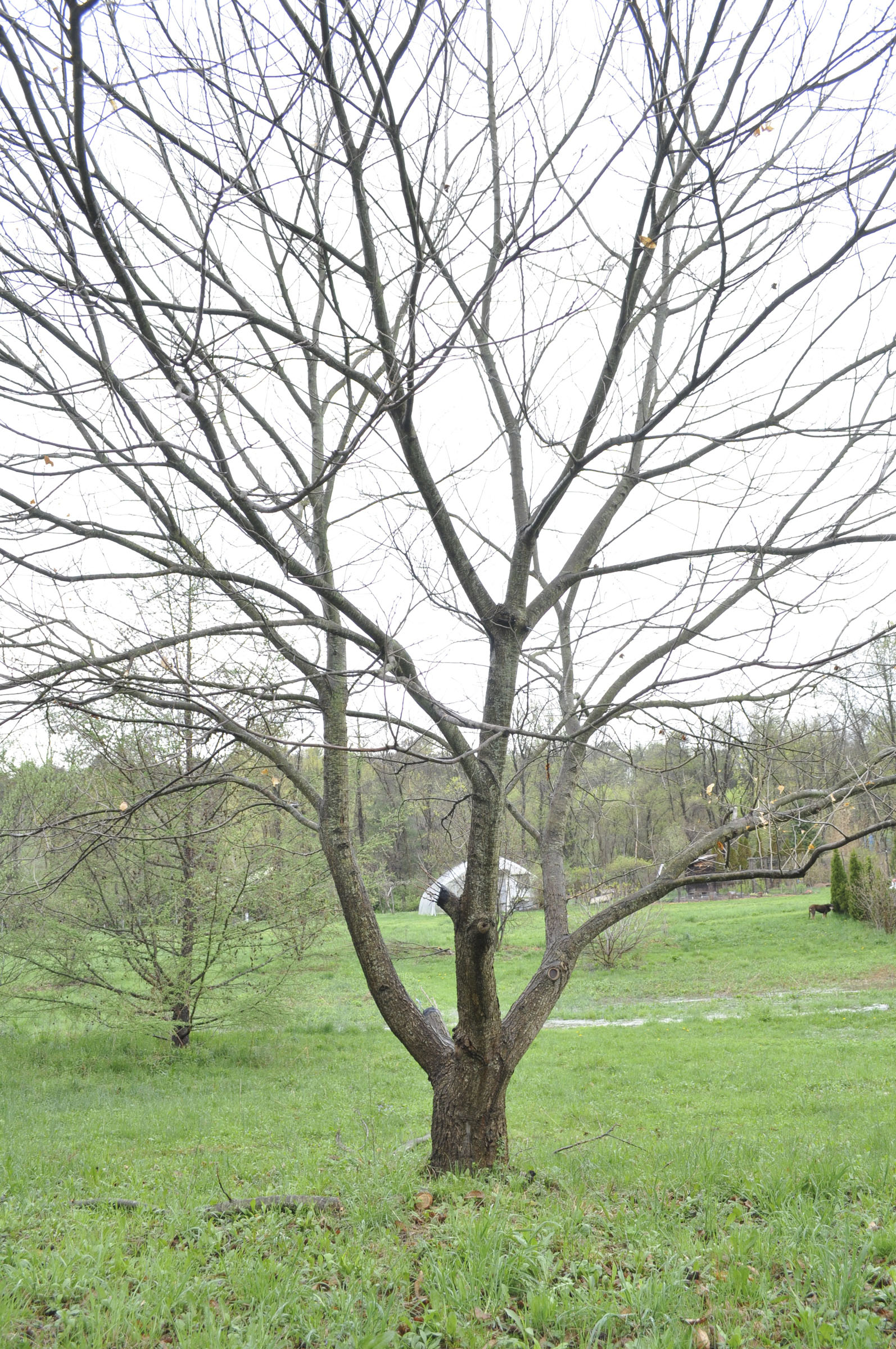
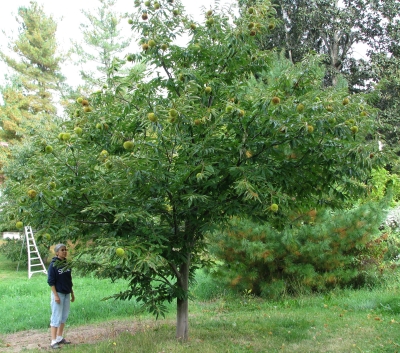
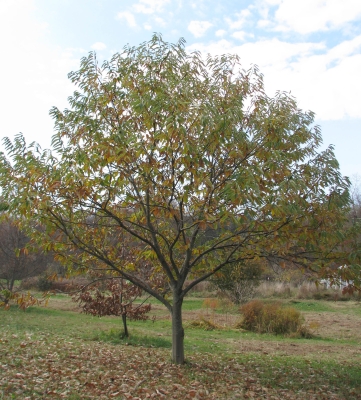
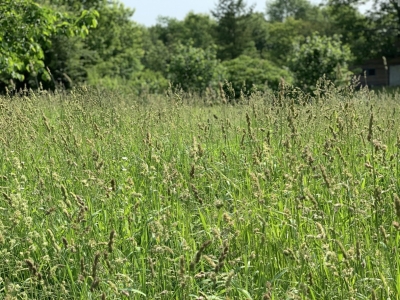 Yet even on the clearest, sunny day — and especially on that kind of day — a dark cloud hangs overhead. Hay fever, literally from hay that is, grasses; and nonliterally, from tree pollen.
Yet even on the clearest, sunny day — and especially on that kind of day — a dark cloud hangs overhead. Hay fever, literally from hay that is, grasses; and nonliterally, from tree pollen.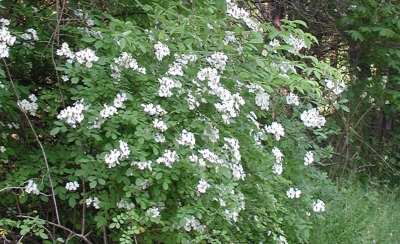 Multiflora rose puts on its show to attract pollinators, such as bees, which transfer pollen from one plant to the next. Hay fever is from airborne pollen blown about by wind, so the flowers of these allergen plants have no need to attract insect pollinators. The non-showy culprits this time of year are grasses and oaks.
Multiflora rose puts on its show to attract pollinators, such as bees, which transfer pollen from one plant to the next. Hay fever is from airborne pollen blown about by wind, so the flowers of these allergen plants have no need to attract insect pollinators. The non-showy culprits this time of year are grasses and oaks.